Dust Dynamics at Mesoscale Resolution

After wrapping up the outgassing mass transport experiment, Elana and I embarked on a new project involving studying how regolith adheres to a spacesuit material. While this work has clear application for future lunar missions, from my own modeler’s perspective, it also gave us data for developing new numerical models of dynamic systems. Specifically, the vast majority of numerical gas kinetic simulations are conducted using static geometries. The computational domain contains some object which is surrounded by some volumetric mesh in which the gas flow is modeled. If any geometrical changes need to be considered then typically the best we can do is consider a sequence of steady-state simulations, as was the case in our ice deposition analysis for the James Webb telescope.
Of course, the real world is not static. I lately became interested in developing the capability to simulate gas flows around objects that can not only move, but can also interact with each other and the gas population. One particular neat application is the interaction of lunar regolith with spacesuits. Figure 1 below shows our sample of one. As you can see, it consists of multiple insulating layers with plumbing for coolant lines. The outer layer is made of material called Orthofabric, which is a combination of Kevlar, Mylar, and Gortex. The woven pattern makes it very easy for lunar regolith to become entangled among the fibers. The dust also easily charges up, leading to an added adhesion due to electrostatic attraction. There is currently an active work in the space research community in attempting to devise methods and devices for reducing dust accumulation in lunar applications.
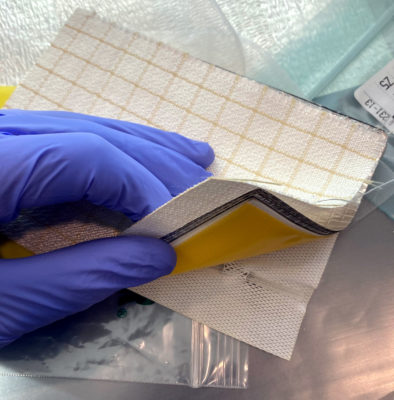
As such, we have embarked on a combined experimental and numerical study of dust adhesion to spacesuits. Besides the spacesuit sample, we also took advantage of a bucket full of JSC-1a regolith simulant we had available in the lab. This article briefly summarizes the work to data, although this is still an active research topic. We have presented this work at the 2021 Spacecraft Charging Technology Conference (SCTC), which was subsequently published in IEEE Trans. on Plasma Science special issue paper titled “Toward Modeling of Charged Dust Dynamics at Mesoscale Resolution”, co-authored by me, Elana Helou, and Prof. Joe Wang. More recently, we also presented updated results, including the high speed videos at the 2023 Applied Space Environments Conference (ASEC). The final version that includes surface-surface rigid body dynamics is expected to be completed in time for 2024 SCTC.
Atmospheric Pressure Experiments
The objective of the experimental work was to determine how likely lunar regolith simulant is to be removed from the spacesuit under several different applied actions, such as shaking, brushing, cleaning with a compressed air, and exposure to the vacuum environment. Figure 2 illustrates the experimental setup that Elana devised to perform the data collection, Essentially an USB microscope is fixed above the spacesuit sample with spots made by a black marker to aid in image alignment.
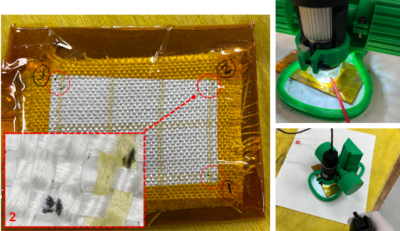
Elana also developed a Matlab script for automating the data processing. It subtracts the image of a clean spacesuit from one containing regolith, and subsequently calculates the percent covered by dust. Figure 3 illustrates this process.
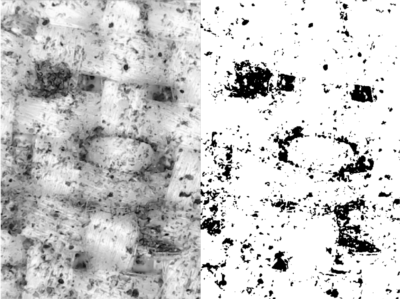
Figure 4 visualizes the dust cover pre and post application of compressed air (top) and shaking (bottom). While compressed air can be seen to produce a cleaner result, some residual regolith grains can be seen to remain.
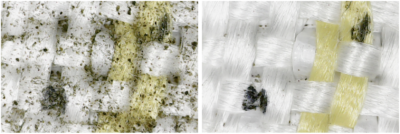

In the Fall of 2023 some students in my ASTE-404 class came across a high speed camera that they needed for their tangentially-related (applicable to plasma propulsion) project. They helped us obtain videos of regolith dropped onto the sample and subsequently being removed by shaking. You can see this footage in Figure 5.
Plasma Experiments
While this is all interesting, our primary initial objective was to characterize regolith adhesion in the presence of plasma. Differential charging between the regolith and the spacesuit can lead to an increased “sttickiness”. High enough charge differentials can even lead to arcing. On the other hand, charging of identical polarity can lead to regolith repulsion. Unfortunately here we came upon some equipment limitations. Specifically we did not have access to an electron gun, and thus were only able to generate glow discharge plasma by exposing high voltage electrode to the chamber pumped only to rough vacuum conditions
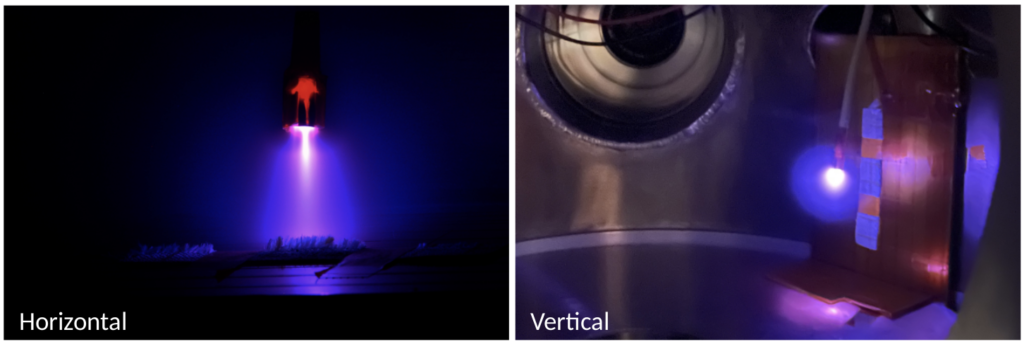
This experimental setup is shown in Figure 6. Figure 7 then summarizes the dust percent area coverage for one of three tests performed at this configuration. The first figure corresponds to the initial dust loading, the second figure is after a pump down and a repress, but no plasma exposure. The final picture corresponds to plasma exposure. As we can see, it does not appear that plasma had much of an effect. We suspect that the glow discharge plasma simply did not produce electrons with sufficiently high energies to induce much charging. We are hoping to repeat this experiment in the future at a dedicated facility with a high current electron source.

Numerical Simulations
In parallel, I have been developing the numerical capability to simulate these experiments. The figure and the video below show some preliminary results, which will be updated in time for STCT 2024. However in essence, CTSP has been modified to support a collection of arbitrarily many surfaces. Each surface stores its own octree which is computed just once, during program start up. Any subsequent surface translations and rotations are performed solely by updating local-to-global transformation matrices. These matrices are used to map between the global and the local coordinates. While this adds an added computational complexity, this added hit is negligible to needing to recompute the octree.
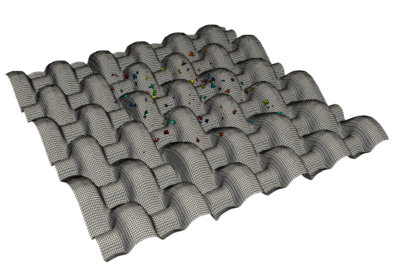
In Figure 8 we visualize the simulation setup, in which some number of random elements representing regolith grains are placed
near a model of spacesuit outer layer. Here the grains are modeled as double sided pyramids but in the future they will be modeled using analytically generated “rocks”. The objects are also placed above the surface since at this point the surface-surface collision model was not yet available. A virtual source is placed above the sample that produces kinetic ions, simulated using the Particle in Cell (PIC) method. PIC particles impacting the spacesuit or the regolith deposit their charge to that surface triangle. No charge redistribution or discharging is included and hence after some time, similar charge builds up on two nearby surfaces. Coulomb force then induces acceleration onto the lighter grains, and they flew off. This is seen in the video below.